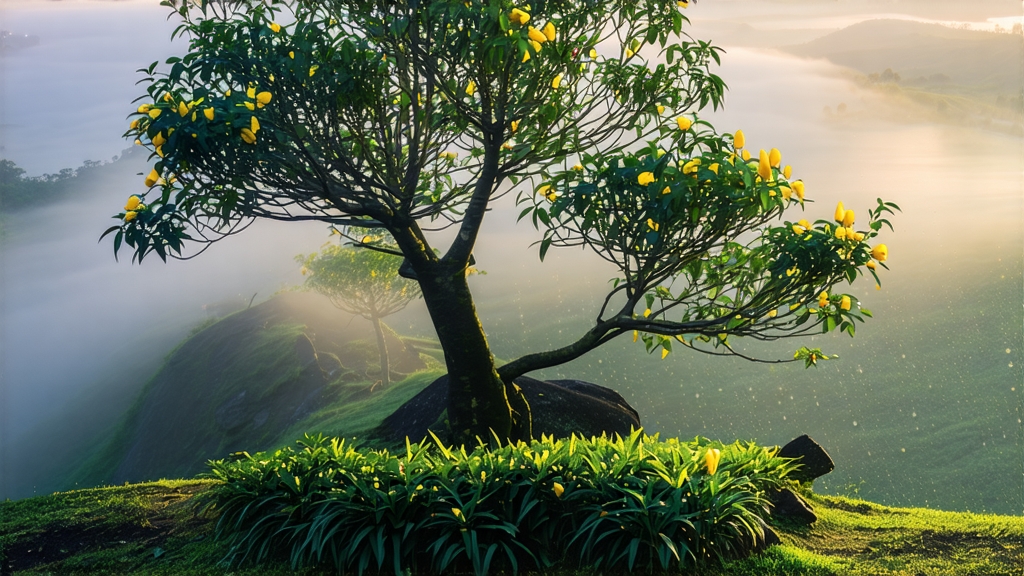
High among the cloud-veiled ridges of Sichuan’s Mengding Mountain, where the first tender shoots of spring are still cool to the touch, a tea once reserved for emperors quietly continues its slow, fragrant metamorphosis. Mengding Huangya—literally “Yellow Bud of Mengding”—is the least-known yet most aristocratic member of China’s yellow-tea family. While green tea is celebrated for its freshness and pu-erh for its earthy depth, yellow tea occupies a slender, twilight zone between the two: it is green tea that has been persuaded to age for a few extra days inside its own moisture, acquiring a mellow sweetness and a luminous straw-gold liquor that seems to trap mountain mist in the cup. To understand Mengding Huangya is to understand why Chinese emperors once weighed it against silver, why poets compared it to “hidden moonlight,” and why, in an age of speed, a handful of artisans still insist on giving the leaves three full days to “return to yellow.”
History: From Daoist Altar to Tang Dynasty Tribute
Mengding Mountain rises just north of Ya’an, where the Sichuan basin collides with the Tibetan Plateau. According to gazetteers compiled during the Western Han, a Daoist recluse named Wu Lizhen planted seven tea bushes on the summit around 53 BCE, convinced that the mountain’s perennial fog was the breath of immortals. By the Tang dynasty (618-907) those bushes—still alive today, crowned as “the seven ancestral trees”—were producing buds so pale they looked gilt, and so fragrant that local officials sealed them in bamboo tubes for the 800-mile journey to Chang’an. The Kaiyuan Emperor (r. 713-741) decreed Mengding tea the first official tribute of the spring season, a status it retained through thirteen dynasties. Caravans carried it westward along the Tea-Horse Road; scholars carried it eastward in memory, praising its “golden frost” and “orchid bones.” When yellow tea techniques matured during the Ming, Mengding Huangya became the benchmark against which all others were judged. Only after 1949, when state tea gardens shifted to mass-market greens, did the variety fade from foreign view. Today fewer than 200 households still master the slow-yellowing craft, making every kilogram a time capsule of medieval Sichuan.
Micro-terroir: Where Clouds Polish the Leaf
Mengding’s terroir is a stack of climatic accidents. At 1,450 m the mountain traps the Yalong River’s humidity beneath cold plateau air, creating 280 foggy days per year. The short-wave ultraviolet light that filters through this veil lengthens theanine synthesis while suppressing catechin bitterness, giving the buds a natural umami sweetness. Soils are Devonian sandstone leached by constant drizzle, acidic (pH 4.8–5.2) and laced with selenium washed down from granite intrusions. Even the night temperature drop—often 12 °C between dusk and dawn—acts like a slow refrigerator, locking floral volatiles inside the tender one-bud-one-leaf pluck. The result is a raw leaf that already tastes faintly of apricot before any human hand touches it.
Plucking Calendar: One Misty Week in March
The work begins when the mountain azalea buds swell but before they open, usually the second week after Qingming. Pickers climb the stone steps at 4:30 a.m. while dew is still heavy; sunlight would oxidize the tips and erase the desired jade-green base color. Only the smallest shoot—the unopened bud and the nearest half-unfurled leaf—qualify. Experienced eyes can judge eligibility in a glance: the bud must be “needle-thin, fish-tail-curved, and silvery at the seam.” A full day’s pluck yields barely 500 g of fresh leaf per person, which will shrink to 100 g after the long yellowing ordeal. In the entire 2023 season the entire mountain produced only 1.8 metric tons of authentic Mengding Huangya, less than the hourly output of a single Zhejiang green-tea factory.
Craft: The Art of Letting the Leaf Suffocate Itself
Yellow tea’s defining step is men huang—“sealed yellowing”—a controlled re-absorption of its own aroma. Mengding artisans divide the process into five acts, each calibrated to the mountain’s hourly weather report.